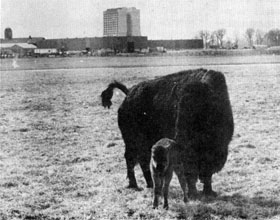NAL Bison - Back Home on the Prairie
The first day of Spring, 1973, had barely come and gone when one of the most delightful manifestations on the NAL site - the first buffalo calf of the year - arrived, unannounced, at 2:20 p.m. on Wednesday, March 21. Madame Buffalo then assumed a safe position in the center of the 80-acre pasture on Road B which is the NAL herd's "range," and cleaned up her 80-lb., chestnut-colored baby while the 25 other members of the shaggy family, one by one, sauntered over to inspect and presumably to welcome the newcomer, then returned to their buffalo business. By Thursday morning the youngster's wobbly legs had steadied enough that it could join the meandering herd, with occasional rest stops when Mother would wisely sink to the ground and the tiny figure would do likewise, usually on the sunny side of Mama.
The event marks the beginning of the second year in which the two original NAL herds have lived in a combined pasture area. In 1970, the Laboratory purchased the first six animals from a source in Colorado. To obtain better cross-breeding, another group of twelve was added in 1971 from a herd owned by the State of Illinois. The two groups were kept in separate pastures until 1972 when they were combined.
Known to be sensitive to familial structure, the animals have apparently now settled into a satisfactory social pattern. There is a dominant cow which has been the big bull's favorite. The young bulls rap horns occasionally to prove who's who. The herd has assumed a more natural pattern, roaming on 80 acres in a style more typical of a large range than a small barnyard.
The largest, oldest bull turned mean some time ago and was kept in "isolation" in a pen across Batavia Road. His days at NAL are numbered; he is dangerous, and a younger bull appears to be better for breeding purposes. With the pleasures of having a fine herd in captivity go the responsibilities of good herd management, says Rudy Dorner, NAL Site Manager.
"We are now beginning a program of tagging and sorting our herd. We'll then be able to keep better track of offspring and inter-breeding.
"Of course, we will cull the herd to achieve better quality. We have six young bulls now. Any more would create a problem and we would suffer from the unproductive battling. We'll be selling some animals; we'll trade with zoos to maintain our stock. Some of our animals may be sold for meat, but this is not uncommon among buffalo raisers. Contrary to what many people think, the bison is no longer in danger of extinction. There are 30,000 in North America, most of them in well-managed herds. But it is important that they be well managed, including being given innoculations for brucellosis, for instance," Dorner says.
Plans continue eventually to have a large herd of buffalo in the center of the NAL Main Ring. But, according to Dorner, if all the animals were to be kept there, they would be inaccessible to public viewing. It is likely therefore that a group of 25 or so will always graze in an accessible location. Presently the herd is fed hay and other feed supplements that have made a noticeable improvement in the coats of the animals. The pasture also has a mud wallow, very important for comfort during fly and insect season. Bare ground provides "itching spots" where the animals roll on their backs, especially in the spring, and thus loosen thick winter hair before the hot weather.
Anyone interested in more information on buffalo will enjoy the book, "The World of the Bison," by Ed Park (Lippincott, 1969). Park explains that the correct name of the North American animal known as a "buffalo" is bison. The true buffalo has no hump; that name belongs only to the water buffalo in Asia and to the African buffalo. But to most Americans, the "bison" is a buffalo and probably always will be, according to Park.
There are two bison sub-species, the Plains Bison and the Wood Bison. The NAL animals are Plains Bison; their origins are Oklahoma and Colorado; their ancestors once covered the vast Great Plains of North America, numbering 50 million at one time. Their unrestrained slaughter in the early 1900's was a tragic part of America's westward development, diminishing the population to about 500. According to a story in the New York Times, the U. S. National Buffalo Breeders Association, formed in 1968, now has 200 breeding members; the total buffalo population is increasing.
Although the NAL herd appears docile and harmless, visitors are asked to remember that these are not tame animals. Do not go into the fenced area or attempt to feed the buffalo.




